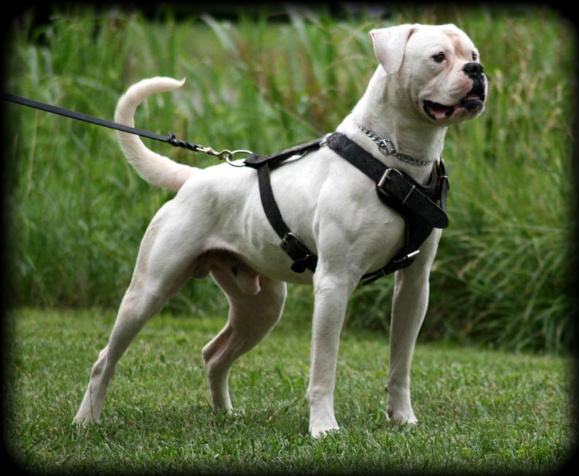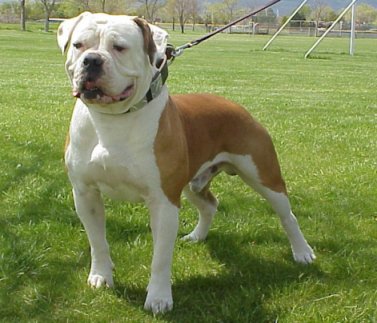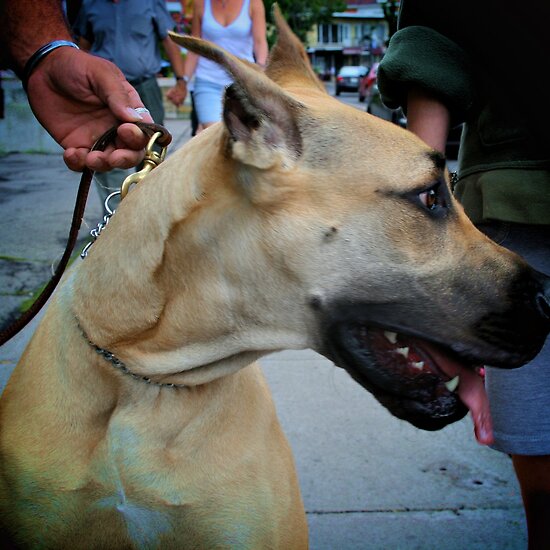Interpreting Canine Body Language
Humans, being unable to sense energy, must instead learn to read body language in order to understand how our dogs are feeling. It's imperative that you do, affection in any form, whether through physical touch, treats/food, or sweet-talking, will reward whatever energetical state your dog's in, so only give affection to a dog in a calm-submissive state.
CALM-SUBMISSION:
See how this pup's ears are drooped down to the sides? They are not pricked forward in a more dominant manner, nor are tucked back flat in fear. Also notice the pup's eyes. See how they seem to "stare" straight ahead? That's a dog in a highly submissive state.
Take a look at the photo below. Pay attention to the bulldog. See how its ears pinned back? The tongue is flicking out in a lick or a "kiss", & the leg is slightly lifted, exposing the soft underbelly & genital area to potential attack. The bulldog is in the highest state of submission, at least in this picture.
Signs of a calm-submissive dog:
Eyes: “soft” (no facial tension), indirect gaze or gaze seeming to stare straight ahead, causing whites to be somewhat visible, not to be confused with the highly visible whites of a fearful dog.
Ears: pinned/tipped back or relaxed to the sides, depending on size, position on head, degree of submission, & shape.
Mouth (if open): lips are relaxed completely, dog may appear to be “smiling” (lips are pulled slightly back at the corners but relaxed); if closed: lips are completely relaxed, no signs of tension or growling. Dog may attempt to lick face or mouth of dominant being.
Head: carried level with the spine (sometimes lower if a dog's sitting down) or held up but not high.
Tail: carried down, possibly curled to the right, & relaxed on long-tailed dogs, carried up but not stiff or slightly down on short- or docked-tailed dogs. (Note: some long-tailed dogs such as German shepherds will carry their tail down even when in a highly dominant state, & some long-tailed small dogs will carry their tails up even when in a submissive state.)
Overall stance: neutral, centered, weight distributed evenly on all four feet on a standing dog. In instances of total submission, a dog will lay on their sides or backs.
FEAR/ANXIETY/NERVOUSNESS/WORRY:
Take a look at this spaniel. At first glance, this looks a lot like a submissive dog. But notice the tail. See how it appears to be curling to the left? That indicates a fearful or nervous state of mind. This dog doesn't appear to be full-out fearful yet, but could be soon.
Notice the glaringly-obvious whites on the above dog's eyes?
Signs of a fearful dog:
Eyes: staring straight at source of fear, whites highly visible.
Ears: tipped back or flat against head.
Mouth: if reacting to an overly-assertive being, dog may yawn in an exaggerated fashion, lick its nose, or try to lick face or mouth of dominant being.
Head: turned towards source of fear.
Tail: tucked tightly between hind legs.
Overall stance: tight, tense, scrunched up, body possibly held low, may be trying to lean away from source of fear. Be very gentle with a fearful dog, as if they're pressed too far, they may snap or bite to protect themselves. Move the dog away from the situation causing fear, if possible, or use calming signals (discussed later in this article), to settle/calm the dog down.
DOMINANCE:
Signs of a dominant dog:
Eyes: staring hard.
Ears: pricked up & forward.
Mouth: open or closed, dominant-aggressive dogs may show teeth.
Head: up high.
Tail: up high, carried low or down on some breeds, may be waving slowly.
Overall stance: puffed up & proud.
CALMING SIGNALS:
Calming signals are used by dogs to both calm themselves down & calm another being down.
THE YAWN
The yawn of a calming signal is large & exaggerated in its fashion. A yawn may also indicate many other emotions including submission, fear/anxiety/stress, frustration, mental taxation, or the working out of a mental problem (in the case of the former, the yawns will be very frequent & exaggerated).
THE LOOK AWAY or HEAD TURN
After establishing eye contact, to prevent potential conflict caused by staring down another being, a dog will purposefully break eye contact by turning their head to the side. Look-aways are only seen in instances of submission or anxiety, unless of course something has caught the dog's attention. A dog may also blink in a slow, exaggerated fashion. This signal has the same meaning as the look-away.
LIP/NOSE LICKS
A stressed, submissive, anxious, or nervous dog may lick its nose or lips (often both) in an effort to calm itself or another being down.
THE SHAKE
A dog may vigorously shake itself off even when dry as a sort of “Phew, glad that's over!” type of signal.
THE SNIFF
A dog may suddenly start sniffing an object or the ground very intently to diffuse a rapidly-intensifying situation, may also show other calming signals.
In conclusion, if you learn to study your dog's body language & take the time to observe the cues they send every day, you open a whole new level of communication you might never have thought possible. Not only are you preventing the behavioral issues that come from affection being given at the wrong time (to a dog in a fearful state, to a dog in an aggressive state, etc.), you can read your dog's energy & body language the way they do yours. You can learn how different situations make your dog feel. The possibilities of communication are endless! But body language can take some time for you to memorize; put in the effort.


















No comments:
Post a Comment